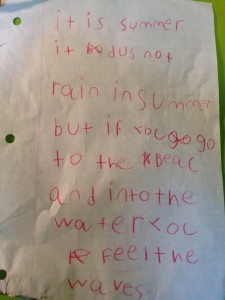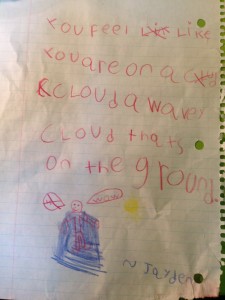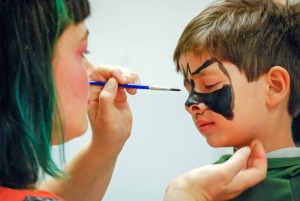
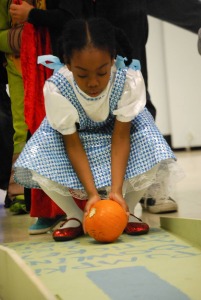
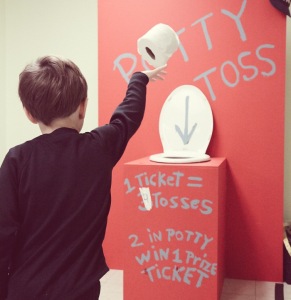
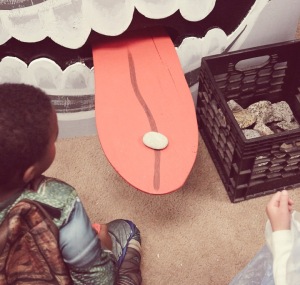
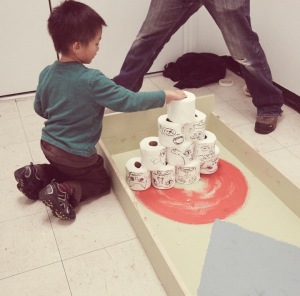





The 10 Question Teacher Interview For Our Woodshop teacher, Rotem Linial!
How long have you been working at The Co-op School?
“This is my first year with The Co-op School.”
What’s your favorite part of being part of The Co-op School?
“I love working with all of the students. It’s been so much fun teaching everyone how to work in the woodshop, how to plan a project and how to execute it, how to work together and be safe. It’s been great learning about the school from the students and I absolutley love that what we are doing is based in curiosity, play and respect. I love coming up with new projects and things for us to build around the school.”
What do you like to do for fun?
“I love making art in my studio, watching movies and hanging out at home, gardening, riding my bike around New York and visiting any one of the million museums we are so lucky to have in this city.”
What’s your favorite restaurant?
“Cocoron in Manhattan, a small Japanese soba restaurant. I love their soba tea and their dipping sobas. It’s a place that makes you really play with your food and build your own meal as you go.”
What’s your favorite sandwich?
“Fresh grilled fish on warm bread with huge chunks of tomato and a squeeze of lemon, parsley and hot pepper, bought and consumed off of a fishing boat in the harbor in Istanbul a few years ago. But second to that has to be the yummy satisfaction of making my own sandwich using bread I baked, tomatoes I grew and picked, scrambled eggs provided by my backyard chickens (see? I can’t help it—I love making things myself…).”
What’s your favorite song?
“I’ve got Nina Simone playing on repeat recently. There really is nobody like her and somehow the changing weather makes her songs go straight to my heart — I don’t think I can pick just one favorite!”
Where do you want your next vacation to be?
“Sometimes I play a game with my friends—if you could go somewhere for a day where would it be? a weekend? a week? a month?
What are you reading right now?
” “A Void” by George Perec (one of my all-time favorite writers). It is a strange book from 1969, famous for the fact that the entire book does not have the letter “e” in it. Pretty incredible (this answer alone has 23 “e”s in it!).”
If you could buy yourself anything what would it be?
“I really have my eye on a open plane ticket around the world…”
What TV sitcom family would you most like to be a member of?
“If they ever made a sitcom based on the Swiss Family Robinson I would definitely want in!”
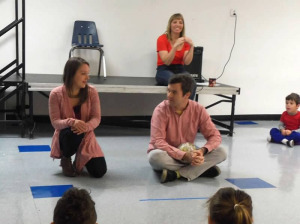
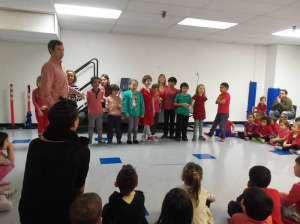
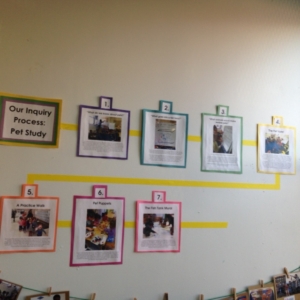
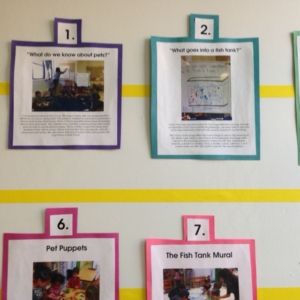
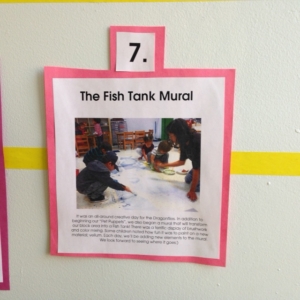
Our elementary school students have so many amazing specials. Here is the October update from our special teachers:
WOODSHOP WITH ROTEM!
Prekindergarten The Bumblebees, Beetles and Dragonflies are working on their wood-pet projects. We started by picking out pieces for our animal’s bodies and observed them closely. We noticed that some sides of the wood were smooth and others were rough and full of splinters. We learned about sandpaper and how to use it to prepare our material. It worked like an eraser for the wood and we “erased” our splinters. When our pieces were ready we decided how we wanted to connect them and introduced the drill. We learned how to use the drill safely (pulling back long hair, removing necklaces, scarves and any loose items), and how to make a “helper hole” for nailing. Using sandpaper, the drill, hammers, nails (and safety gear of course) we started assembling animals. Once the animals are ready we can start thinking of what else they will need—habitats, homes, food, friends and more.
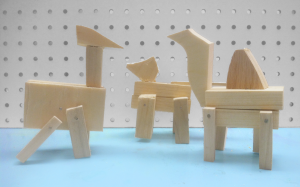
Kindergarten (Katydids) is almost done with their treasure chest projects. After attaching all of our pieces, making the boxes that are the body of the treasure chest we attached our lids. To do this we introduced the idea of hardware and how it can help us in our projects. Using metal hinges that connect across two pieces allow those parts to move. We though about where else we see hinges and talked about doors and windows. To attach the hinges to the box and lid we used the drill and screws. We talked about how screws work—a simple machine that helps us do something. We looked at the threads, the point and the head and practiced using screwdrivers using Phillips screws and foam balls. Then, using the drill we made “helper holes” and put our screws in. We are ready to finish the treasure chest, paint, add handles, locks and decorations and see what treasures we find to fill them.
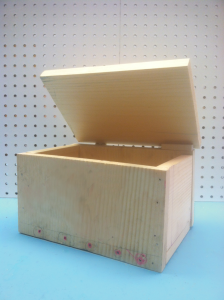
First Grade (Centipedes) is wrapping up their city building projects and will soon bring all of their separate creations together to make one big Shark city. We continued using the tools we learned in earlier classes—using hammers, nails, saws and vices—and introduced the drill. We learned how to use the drill and talked about how it can help us build things. After a demonstration we looked closely at the drill and talked about drill bits and how they work. We are using the drill to make “helper holes” that make it easier to nail wood together and to make sure small pieces don’t split. We are now putting the final touches on our buildings, painting them, adding final elements and are now beginning to think about how different parts of the city combine to make a whole. Our city will have a grocery store, a train station, launching pads for rockets, a cat shelter and more!
Second Grade (Sharks) is wrapping up their “Subway of the Future” project—putting on some final touches, painting and attaching the subway car to each other. After completing the body of our subway car we made plans for our subway. Where will it go? How will it get there? There were exciting ideas—flying double decker trains, trains with horns, trains that fold, trains that shape-shift and more. We added elements to the body of the train and used the drill to make “helper holes.” We went over the safety rules for using the drill and practiced making holes. We added wheels to our subway, making sure not to nail all the way so that the wheels could still turn. We are now decorating our train and will be adding eye hooks so that we can attach our car to one another. Together we will make a winding train track, tunnels and bridges for our subway to ride on (or fly off of…).
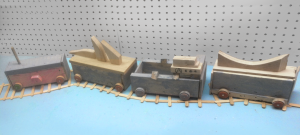
——————————————————————–
SCIENCE WITH NICOLE!
It has been an exciting October in the Science lab! The classes have moved into their Fall science studies which they will continue through November.

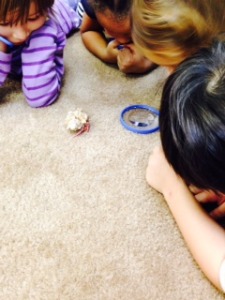
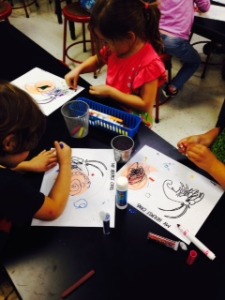
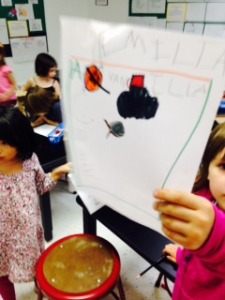
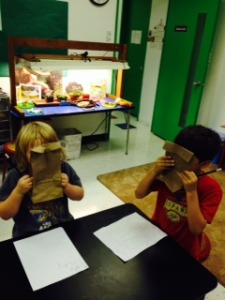
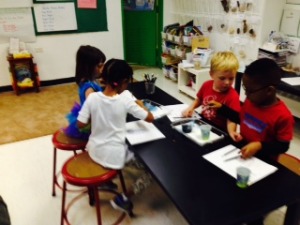
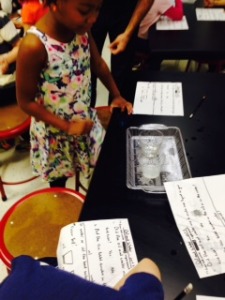
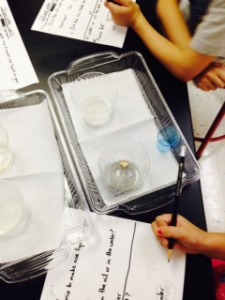
—————————————————————————
MUSIC WITH DAN!
Pre-Kindergarten
Beetles children love to rock! Every song we sing seems to end up in a Rock ’n Roll version – “Itsy Bitsy Spider,” “ABC’s,” and even “Baa Baa Black Sheep.” Cole brought in a song he had written at home called “Chocolate Milk Rock”. We’ve been working on dynamics – how to sing Rock ‘n Roll without shouting. This is definitely a work in progress! The song “Mama’s Sleeping, Don’t Wake Her Up” is a great way to practice loud and soft. Since our class is thinking about pets we’ve been singing songs about animals including “I Bought Me A Cat,” “B-I-N-G-O,” and “A Slippery Fish”. One day we came up with ideas for a Hamster song. “What will we name him?” Recently the Beetles have been introduced to The Beatles, and we sang “I Want To Hold Your Hand.” In our last class James Lucy was the conductor, and we had to watch for her waving her wand. If she stopped waving, we had to freeze our voices and our instruments, until she started waving again. Everyone wants a turn to conduct and we’ll get to everyone eventually! We also worked on pronouns – identifying I, He, She, You, Them and We in an Ella Jenkins song called “Who Fed The Chickens?”
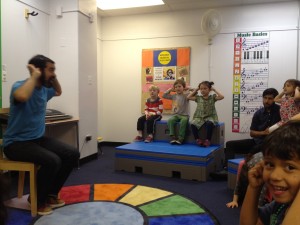
Dragonflies have established that they really love two songs in particular: “Subway Train” and “Jump In The Water!” Their class has been deciding about pets and so we have also been singing a lot of animal songs – “I Bought Me A Cat,” “B-I-N-G-O,” and “A Slippery Fish” among them. Many children have been singing songs from home in our class, and being very brave to take center stage and perform them for the class! Jackie sang “Let It Go” and Zelig sang a song from “Cars.” Ella and Farah demonstrated how to sing “Itsy Bitsy Spider” and do the movements at the same time.
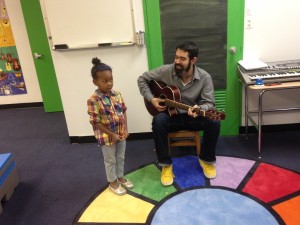
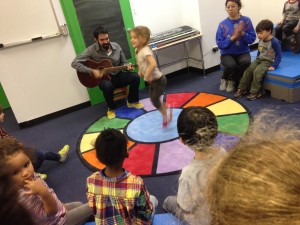
Bumblebees are excited about their soon-to-be-selected class pet. We recently sang “You Can’t Make a Turtle Come Out” by Malvina Reynolds, a song about being kind to animals. We also talked about many animals in “Subway Train” by the Pop-Ups. The Bumblebees have been matching pitch quite well, confidently finding the Little Richard-inspired “oooh!” at the end of “Rock ’n Roll Itsy Bitsy Spider.” They also love to “Jump In The Water”, with each child’s name being sung as she / he jumps in the center. The Bumblebees also really enjoyed this year’s Halloween jam, “Five Little Pumpkins.” As The Bumblebees have been been working on spelling their names in their classroom, we sang “B-I-N-G-O,” incorporating the rhythm of clapping to the silent letters. Next month the Bumblebees will be writing and recording a class song.
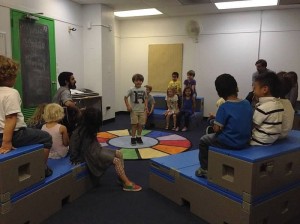
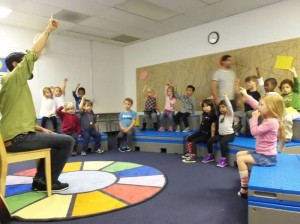
Kindergarten (Katydids) worked a lot with the concept of RHYTHM. We asked, “What is the BEAT?” and tapped it using rhythm sticks, our feet, hands and voices. The Katydids were particularly excited to dance around to Stevie Wonder songs, and we identified some of instruments we heard in the recordings: bass, piano, guitar, drums, and trumpet. Several children delighted in sharing their rendition of Stevie Wonder’s “Happy Birthday” song. We investigated the concept of REST and how a REST is different from a NOTE. We incorporated the classroom study of stories to tell the tale of “Abiyoyo” and discussed the detailed list of events in “The Green Grass Grows All Around.”
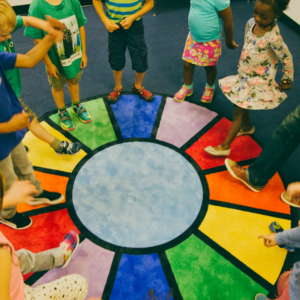
First Grade (Centipedes) have been working very hard on learning about rhythm. Our class moved to music to experience different tempos and styles, and we reflected the changes by moving our bodies differently, depending on what we heard. The Centipedes wrote and recorded an incredible anthem called “1, 2, Centipedes.” We split our class into 1’s and 2’s, and practiced clapping at different times. Our class had a great discussion about which lyrics we could use in our song. It was hard to remember the order of the lyrics, but then we practiced until we felt we had it memorized. Our class is making lots of progress working as a group, listening to our teachers and friends. Akiru and Ben each got a turn to demonstrate playing instruments at our classroom open mic, and Lilac and Danika sang a song together. In our most recent class we learned about how a REST in music is like resting our bodies and voices. We practiced with rhythm sticks how to play on the beat, following the conductor, and how to remember what beat we’re on without counting out loud!
Second Grade (Sharks) started October by moving to music in different ways. We walked around our room while reacting to changes in tempo and style. We used the piano and also recorded music for references. We listened to music and found the BEAT. We clapped rhythms and used rhythm sticks. We learned about TEMPO and played some conducting games where children had to follow a conductor who waved his arms to indicate the speed of the beat. We practiced sing-along songs in three tempos – PRESTO (fast), MODERATO (medium), and LARGO (slow). One day when Ryan was sick, we wrote and recorded a “Feel Better Song” and sent it to him. (It worked!) Our classroom Open Mics have been exceptional, with some children sharing a Rock ‘n Roll version of “Let It Go” and others demonstrating their piano skills. Isaac played “You Are My Sunshine” for us, and he told us how difficult it was for him to learn it, but now it’s easy for him to play. Then we asked if he could do it with his eyes closed – and he did it! The children are working on their class play, “Willy Wonka.” Jocelyn asked Dan for help with the music, so we started learning an opening number – “If All The Raindrops Were Lemon Drops and Gum Drops.” We’re going to work on music for the Oompah Loompahs, and a special closing number in November.
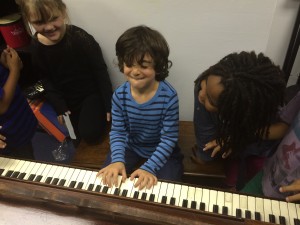
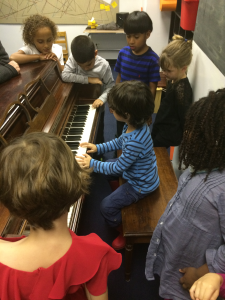
——————————————————————————————–
ART WITH KARA!
Pre-Kindergarten (Dragonflies, Bumblebees & Beetles) The Pre-K has been investigating shapes within different mediums and materials. We started out by combining and arranging pre-cut shapes to make animal collages. The following week, we discussed pattern and how shapes, colors, sounds, letters and even numbers can be repeated to become a pattern. We searched for patterns everywhere, finding some on our clothes, on buildings and even in the classroom. Classes experimented with various shaped cork stamps to see how they could create patterns with different shapes and colored ink. Stamping continued the next class, this time using only black ink and stamping materials sourced from the resource room. Favorites were bubble wrap, packing peanuts, paper towel rolls, caps and cardboard. We read Lio Lionni’s book Swimmy, which was illustrated exclusively with fish-shaped stamps and various other materials. Next week, students will choose how they will add color to their monochromatic stamped images, looking for patterns, shapes and lines.
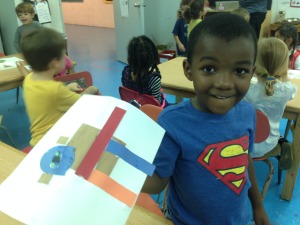
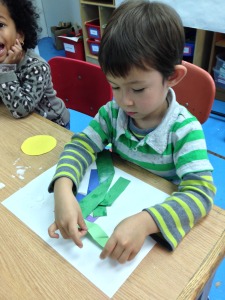
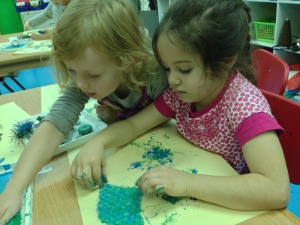
Kindergarten (Katydids) The Kindergarten has been continuing their study of recycled materials by building assemblage sculptures. The Katydids looked at images of work by Louis Nevelson, a New York City based artist who created sculptures from materials she found on her walks around her neighborhood. The Katydids recognized in Nevelson’s work- steering wheels, table legs, pipes and all sorts of triangles, squares, rectangles and circles. Utilizing recycled materials from the resource room, the Katydids collected various shapes and materials to create their own assemblage. Just as Nevelson painted her sculptures to be monochromatic, the Katydids are in the process of painting and disguising their individual sculptures in black paint before combining them to make one large sculptural work. The finished sculpture will be installed outside the art studio in the basement.
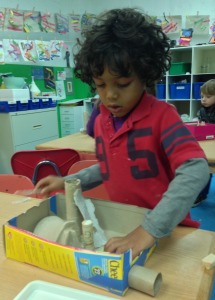
First Grade (Centipedes) Over the last several weeks, the centipedes have been busy working in paper construction. We began by discussing architecture and how architects make blueprints and models of the buildings they plan to construct. We observed images of adobe structures and contemporary New York City skyscrapers to compare and contrast the forms. Some building had forms that were repeated many times. With this is mind, the centipedes sought our to discover how to build a city out of paper. Beginning with a paper construction exploration, the centipedes learned how to fold strips of paper to make them stand up, and then how to build a paper cube. Building the cubes was challenging as it was discovered that the amount of glue that was applied was important to determine whether the cube would stand. The centipedes shared their challenges and solutions, working together to solve their construction problems. Individually they decided, if they would be tall or short structures, narrow or wides. Finally, the completed buildings were combined and arranged to create a whole city.
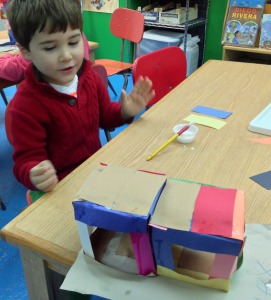
Second Grade (Sharks) The Sharks are continuing their transportation inquiry study in the art studio. We started off the month with a slide presentation of mosaics in the NYC subway system, looking at the various images and colors and learning about the process of mosaics. With the goal of a group mosaic in mind, the sharks brainstormed types of transportation in NYC and each chose three to make a sketch of. We are in the process of preparing and painting the mosaic base, sorting and organizing the mosaic tiles, or tesserae, and combining our sketches to create one NYC based transportation mosaic. Students will take turns collaborating on the class mosaic, and will also create individual mosaics to explore the technique of mosaic and troubleshoot any challenges that arise.
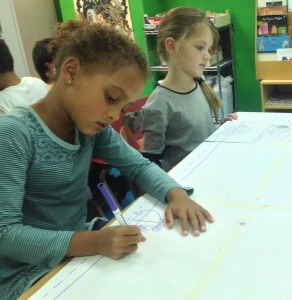
————————————————————————————————————–
SPANISH WITH CARLA !
Kindergarten (Katydids) ¡El otoño está aquí! And we are having a wonderful time learning about fall and its colors. We continue to extend our knowledge of numbers (1-12), colors (plateado/silver, dorado/golden, colores brillantes/shiny colors), and shapes. We are currently working on fall festivities such as Día de muertos/Day of the dead, Halloween, and prepping for Día de acción de gracias/Thanksgiving day. ¡Fantástico grillitos!
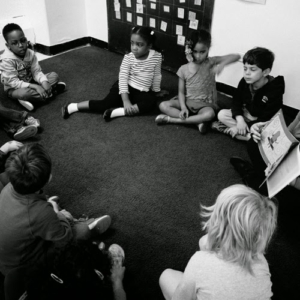
First Grade (Centipedes) Our wonderful ciempiés have been working so hard as a community! I am really proud and honored to be a part of this learning experience. We are currently working on a unit about family and we are correlating this topic to the festivities celebrated during fall. We also started having “Viernes divertidos”/”Fun Fridays”, where we get to have independent play at three different stations: loteria/bingo, memoria/ memory, and pretend play. ¡Muy bien ciempiés!
Second Grade (Sharks) Los tiburoncitos/sharkies are having a great time in Spanish class. We have been learning a lot about our families. We are also getting ready to talk about families in Central and South America, and we will correlate this topic to the space and environments we live in (casa/house, departamento/apartment, ciudad/city.) As for now, we are getting ready for all the fall celebrations including: Día de muertos/Day of the dead. ¡Hasta pronto!
————————————————————————————————————–
GARDENING WITH SOPHIE!
The 10 Question Teacher Interview For Our Music Teacher, Dan Costello!
How long have you been working at The Co-op School?
“This is my first year!”
What’s your favorite part of being part of The Co-op School?
“I really love singing with everyone. It’s such a joy to share songs we know and to teach each other new songs we hadn’t heard before. And I especially love it when we learn a new song from one of the children! I’m also very happy to be working in my neighborhood – I love that The Co-op School is part of my community.”
What do you like to do for fun?
“Of course, I play music! I write songs and perform in several bands. I also like to be outside, either gardening or running or bicycling. Lately I’m very interested in exploring the areas of NYC which in my dozen years as a resident I’ve never visited! Can’t wait to see the new section of the High Line!”
What’s your favorite restaurant?
“Il Corallo in Soho. But don’t tell anyone – it’s a secret! (Psst – Get the Fettucine Pescatore!!) I must also shout out to Peaches Hot House in Bed-Stuy!!”
What’s your favorite sandwich?
“The other day I had prosciutto, mustard, arugula and tomato on focaccia bread. It was so great. I’m also a whole-wheat-everything-bagel-
What’s your favorite song?
“”This Land Is Your Land” by Woody Guthrie.”
Where do you want your next vacation to be?
“Morocco and Spain. Or New Orleans.”
What are you reading right now?
“I always read several things at once. Currently I’m working through these: “Dylan At The Crossroads” by Greil Marcus (thanks Lending Library!), “The Dramatic Imagination” by Robert Edmond Jones, “Team of Rivals” by Doris Kearns Goodwin, and this week’s New Yorker.”
If you could buy yourself anything what would it be?
“Hmm, that’s tough to answer. Maybe a farmhouse near NYC for the weekends and vacations! I enjoy the fresh air and the landscape in the country, but I love that Brooklyn is my home.”
What TV sitcom family would you most like to be a member of?
“I don’t watch any sitcoms these days! When I was a child I imagined being one of the Seavers on “Growing Pains.” They were all so smart and funny!”
We had our first Town Hall on October 7th. This is time when the entire elementary school comes together monthly to share what is happening in each classroom and to talk about school wide news. During this first Town Hall we went over what Town Hall was and we also talked about how to use our Imagination Playgrounds blocks in a safe, fun way on the playground.

One of our amazingly articulate second graders explained what Town Hall was to the school.



Teachers Stephen and Alistair demonstrated the right way to share and play with our blocks.
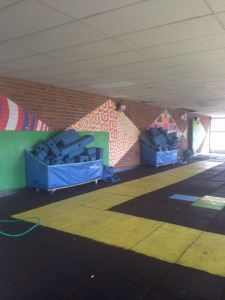
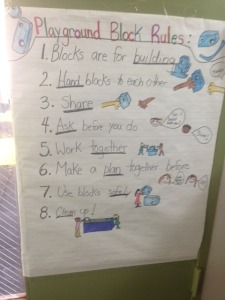
Here are our new posted rules for everyone to see!
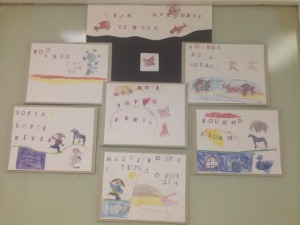
Our elementary school students have so many amazing specials. Here is the September update from our special teachers:
WOODSHOP WITH ROTEM!
The Bumblebees, Beetles and Dragonflies:
The pre-k learned a lot this month in the woodshop. We learned about woodshop safety—how to protect our bodies and our friends. We went over the safety gear, goggles and headphones and how to handle tools and materials in the shop. We also learned a song that will help us concentrate in the woodshop. We learned how to hammer using hammers and nails. We practiced holding and aiming nails using foam practice boards. Our boards had pictures with missing parts and numbers on them—we found the numbers and completed the pictures using nails. This week we learned how to use the coping saw. Using our foam practice boards we first marked our cut and, using the vises, practiced sawing. I’m excited to see what the Bumblebees, Beetles and Dragonflies will make with all of their new woodshop skills…
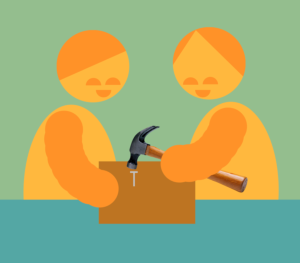
The Katydids:
The Kindergartners started working on a treasure chest project. We went over all of the important woodshop safety rules. We talked about the different ways we can help protect our bodies and how to work together in the woodshop—from goggles and headphones to how to walk with tools and the importance of being concentrated in the shop. We practiced planning and marking our material and following our plan. We sanded our wood, lined up out material, made marks for nails and prepared our pieces. We used sandpaper, sanding blocks, hammers, nails, saws, vices and clamps. We will be making treasure chests for keeping all of our interesting objects, materials and images.
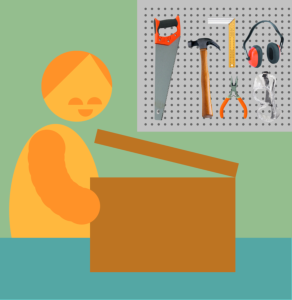
The Sharks:
The first graders are working on building the subway of the future. We started by talking about how the subway has changed since it was first built and then we tried to imagine what might happen in the future. What will the subway look like in 100 year? Where will it go? How? With these questions in mind we each designed a single subway car from the future we imagined. Using our designs started assembling the different parts of our cars. We are now working on building a base for each car on which we will add everything our subway will need. We practiced marking our material and making a plan, using the vises, hammers, saws and nails. We went over woodshop safety—hammer walk, goggles, headphones, concentration and respecting our friends space as they work.
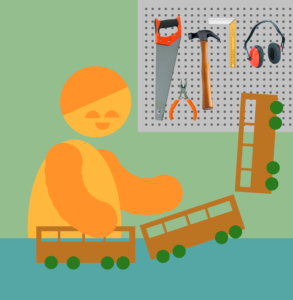
The Centipedes:
The second grade reviewed woodshop rules and safety that they had learned last year. We went over how to protect our bodies and friends, the reasons for wearing safety gear, how to handle tools and why it’s important to stay focused in the woodshop. The Centipedes discussed how woodshop relates to construction and how we can learn about building and making things using different materials and tools. We talked about construction and are now working on building a city! Each Centipede is building one building. We made plans and designs and decided what kind of building we each wanted to build—houses, dance halls, train stations and more. I’m excited to see what kind of a city we get when we put all of our buildings together…
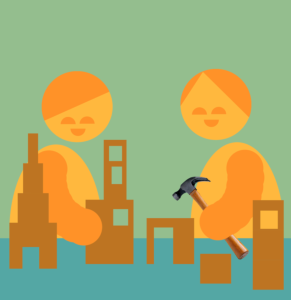
SCIENCE WITH NICOLE!
Beetles:
It’s been such a pleasure getting to know the Beetles. In early September, we began by getting acquainted with the new layout and guidelines of the art studio and getting to know the materials. The Beetles were introduced to their personal sketchbooks, that they will be working in this year and got right to work on decorating and personalizing them. Their sketchbooks are an outlet for free drawing or writing at the end of class when there is extra time. Since then the Beetles have been learning about different types of line. We started by discussing the difference between paintings and sculptures, and looked at work by Alexander Calder and the Statue of Liberty. The Beetles learned that by folding the ends of their paper lines into “feet,” and gluing the bottom of their feet, their lines could pop off the paper and become a sculpture. The Beetles’ line sculptures have become even wackier with the addition of zig zag lines, curls, loops and shapes last week. At the end of class, we spent a few minutes reading from the book When A Line Bends, A shape Begins by Rhonda Gowler Greene.
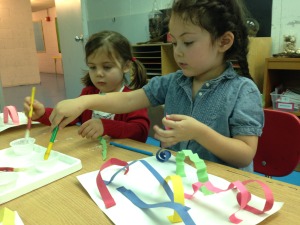
Dragonflies:
The Dragonflies are off to a great start in the art studio. We took the first class to get acquainted with the new layout, materials and guidelines of the studio. The Dragonflies decorated and personalized their new personal sketchbooks that they will be working in this year. Their sketchbooks are an outlet for free drawing or writing at the end of class when there is extra time. Since then, the Dragonflies have been learning about different types of line. We started by discussing the difference between paintings and sculptures, and looked at work by Alexander Calder and the Statue of Liberty. The Dragonflies learned that by folding the ends of their paper lines into “feet,” and gluing the bottom of their feet, their lines could pop off the paper and become a sculpture. The Dragonflies’ line sculptures have become even wackier with the addition of zig zag lines, curls, loops and shapes last week.
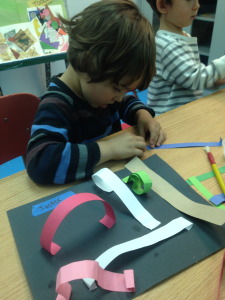
Bumblebees:
The Bumblebees have had an impressive start in the art studio. In early September, we began by getting acquainted with the new layout and guidelines of the studio and learning about the materials we would be working with. The Bumblebees were introduced to their personal sketchbooks that they will be working in this year and got right to work on decorating and personalizing them. Their sketchbooks are an outlet for free drawing or writing at the end of class when there is extra time. Since then the Bumblebees have been learning about different types of line. We started by discussing the difference between paintings and sculptures, and looked at work by Alexander Calder and the Statue of Liberty. The Bumblebees learned that by folding the ends of their paper lines into “feet,” and gluing the bottom of their feet, their lines could pop off the paper and become a sculpture. The Bumblebees’ line sculptures have become even wackier with the addition of zig zag lines, curls, loops and shapes last week. At the end of class, we spent a few minutes reading from the book When A Line Bends, A shape Beginsby Rhonda Gowler Greene.
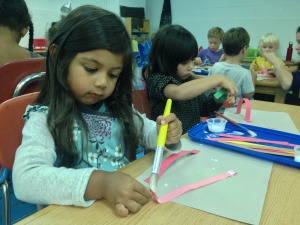
Katydids:
The Kindergarteners are off to a fantastic start in the art studio. We took the first class to get acquainted with the new layout, materials and guidelines of the studio. The Katydids decorated and personalized their personal sketchbooks that they will be working in this year. Their sketchbooks are an outlet for free drawing or writing at the end of class when there is extra time. The next class we jumped into collage, exploring paper with varying patterns, textures and shapes. Collage provides tactile opportunities to arrange and modify ideas and see how their physical actions have visual consequences. The Katydids collected various paper of their choosing and created either a design or a collage of a special activity that they do with their family. Currently, the Katydids are working on collage self-portraits made from cardboard and other recycled materials from the resource room. Beginning with pre-cut cardboard shapes, the Katydids selected pieces to represent their body and have been busy adding details and facial features to their cardboard bodies with fabric, beads, buttons, feathers and yarn.
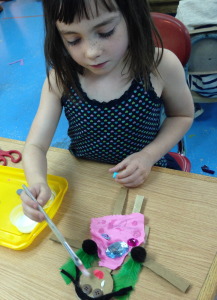
Centipedes:
The First Graders are off to a great start in the art studio. In early September, we began by getting acquainted with the new layout and guidelines of the studio and getting to know the materials. The Centipedes were introduced to their personal sketchbooks that they will be working in this year and started off decorating and personalizing them. Their sketchbooks are an outlet for free drawing or writing at the end of class when there is extra time. Since then, they have been working on a watercolor painting in which they represented their favorite thing about the Co-op School. We began by discussing our school community and what makes it special. The Centipedes took time to write down their ideas, before moving on to a drawing. The following class we did a watercolor exploration investigating how to mix and best spread watercolors on paper. The Centipedes then added watercolors to their drawing. This watercolor painting “quilt” will be displayed in the basement hallway when finished.
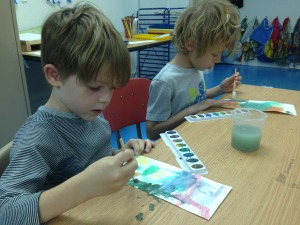
Sharks:
The Second Graders are off to a fantastic start in the art studio. We took the first class to get acquainted with the new layout, materials and guidelines of the studio. The Sharks decorated and personalized their new personal sketchbooks that they will be working in this year. Their sketchbooks are an outlet for free drawing or writing at the end of class when there is extra time. The next class we jumped right into transportation collages. We discussed different types of transportation as well as our favorite ways to travel in the city. Since then, the Sharks have been working intently on their transportation collages, selecting, cutting, arranging and pasting paper of various textures, patterns and shapes to best represent their ideas. Some are based on real life events, some fantastical. I am really proud of how hard they are working and can’t wait for you to see them.
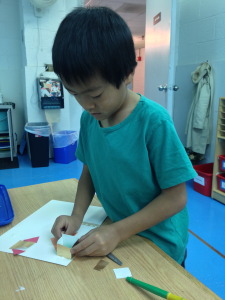
Dragonfly:
Prek Dragonflies did some great seed saving! We started off investigating an ear of corn Red Seneca Corn, an ornamental corn that originated with the Seneca Nation of Indians, and grown in the Irving Co-op Garden from organic seeds donated by a Co-op parent. We noticed that the husk of this ear of corn was dark red rather than green and talked about how each kernel of corn could become a new huge corn plant.
Vocabulary – husk, silk, ear, cob, kernel, stalk
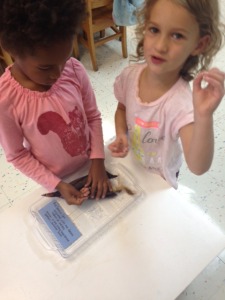
We then moved on to cucumbers, one that we picked from the dragonfly planter and one that was donated by a Co-op family. We talked about how the smaller cucumber was best for eating and the large cucumber was great for seed saving. When I cut up the smaller cucumber we talked about how the seeds were thin and you could sort of see through them and wouldn’t grown into new plants because they weren’t fully grown seeds (sterile). When we cut open the larger cucumber we noticed how these seeds looked fatter and were a different color. We then ate some cucumbers and squished the seeds to separate them.
Beetles:
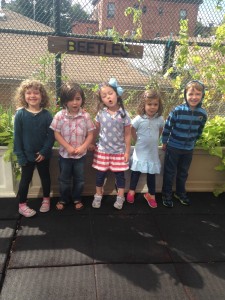 Beetle gardening class in front of their planter
Beetle gardening class in front of their planter
In gardening class we talked all about seeds and did some great work harvesting and collecting seeds! We started off looking at an ear of corn Red Seneca Corn that was actually grown in the garden at Irving . This organic corn seed was donated by a coop parent and originally purchased from Seed Savers. We talked about how normally the outside of the ear of corn is green, but with this particular variety the husk is dark red. Hence the name, Red Seneca! We also talked about how each kernel of corn could grow into a new corn plant! After investigating the ear of corn for a bit we moved on to some sunflower seed heads. These sunflower seed heads were also grown in the Irving garden and originally donated by a coop parent. We looked at the seed heads and started harvesting the seeds from the seed head. We noticed that there weren’t a lot of seeds and I told them that the birds had eaten most of the seeds, but that’s okay because birds get hungry too!
The Beetles did some great work harvesting the sunflower seeds and wanted to plant them immediately. We then talked about how it is best to plant seeds in the Spring. After collecting some seeds we brought them up to the classroom to add to the beetle science area.
Katydid:
Class 1: We observed a couple members of the squash family, a summer squash (ronde de nice), and two winter squash, a baby pumpkin and a fordhook acorn. When we sliced open the ronde de nice and pumpkin we discovered that those seeds were underdone and most likely sterile. Oh well. But we had success with the fordhook acorn! We washed the seeds in some water and placed them in a paper towel to dry off.
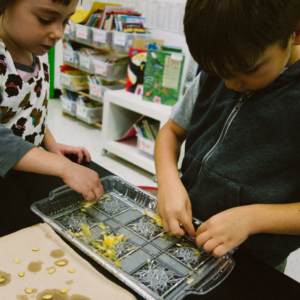
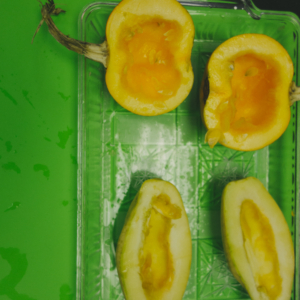
Class 2: We did some fantastic heirloom tomato seed saving and Red Seneca Corn observational drawings.
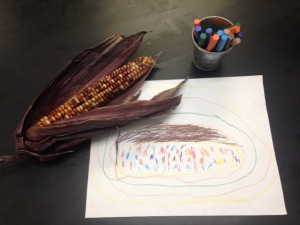
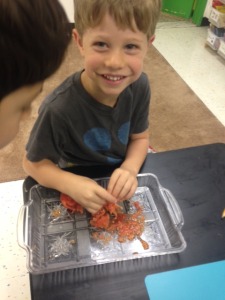
We then tasted a delicious heirloom tomato and some of us even had thirds and fourths!
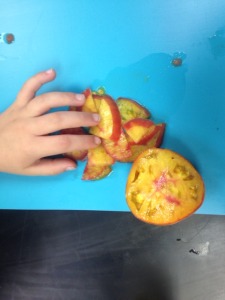
We then went up to the rooftop garden to work in our planter transplanting some carrots and refreshing the soil with compost.
Centipedes:
The First Graders observed Red Seneca Corn and harvested and ate cucumbers from the garden. We worked on our plant vocabulary (husk, silk, ear, cob, kernel, stalk) and discussed how each kernel could become a new plant.
Sharks:
The Second Graders had a great circle time conversation about seeds and looked at the Red Seneca Corn! We learned new gardening vocabulary and were kind of excited to learn that we eat different seeds all the time! We then went up to the roof to pick and eat the largest cucumber we could find in the garden. After snacking on some cucumbers we did some plant identification work and learned how to identify the different bean plants that are growing in the Brevoort garden, green bush beans, purple bush beans, and purple climbing beans!
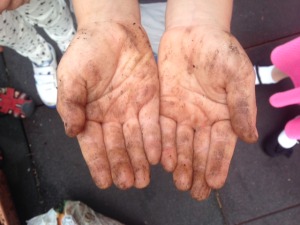
SPANISH WITH JEAN CARLA!
Katydids:
Our Kindergartners have been having a great time learning Spanish with “los grillitos.” So far, we have learned about identity, greetings, intro to months/seasons. We are currently learning about body parts, numbers (1-10), and colors. Literacy is very important so we have been reading books related to the themes we are working on. It is very significant for our class, if you practice with your child at home (always having fun) so that we can stay on the same page.
Centipedes
Our First Graders have been having a wonderful time in Spanish class with “los cienpiés.” We are currently practicing how to express our feelings through our morning greetings. Further more, we are applying our previous knowledge of numbers, colors, shapes, etc. to an exciting unit about the vowels and the alphabet. Please support our efforts by practicing with your child at home (always having fun). You can also attend cultural events and/or watch shows/videos in Spanish with your child.
Sharks
Our Second Graders have been having a great time in Spanish with “los tiburones.” We are currently practicing how to express our feelings during our morning greetings. Further more, we are applying our previous knowledge of numbers, colors, shapes, etc. to an exciting unit about the vowels and the alphabet. Literacy is very important so we have been busy at the library researching about vocabulary related to the vowels. Great job tiburones! Please support our efforts by practicing with your child at home (always having fun). You can also attend cultural events and/or watch shows/videos in Spanish with your child.
CAPOEIRA WITH PENA FOR PRE-K!
GYMNASTICS WITH JULIAN FOR K-2!
